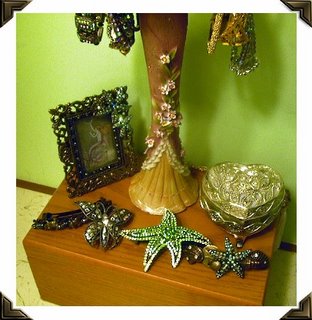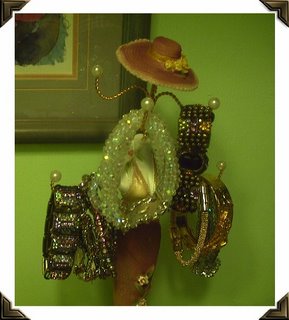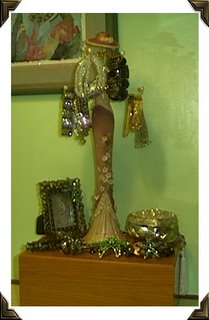




Hi to all,
Tis a favorite time of mine the celebration of Imbolc. January 31- February 2nd
The bringing of new life to the earth. I really am so glad to see it here
already.. I will be enjoying my day with mother earth..
Here is a little history, lore and ways to celebrate the holiday.
Love & light
Bee
IMBOLC:
This season belongs to Brigid, the Celtic goddess The powerful figure of Brighid the Light-Bringer over lights celebrations of the life-giving forces of spring. . The earliest whisperings of Springtide are heard now as a time of the year associated with beginning growth.
Here we plant the "seeds" of our hopes and dreams for the coming summer months.
**This celebration signals the middle of the season of long nights and anticipates the upcoming season of light. Celebrants make Corn Maidens from corn and wheat. The Maidens are dressed up and placed in a cradle known as a "Bride's Bed". A wand, usually tipped with an acorn or other large seed, is placed in the bed with the Maiden. The Maidens are generally kept year round as a symbol of fertility.
Other interrelated interpretations of the festival center around the Irish Goddess Brighid, known for her healing, smithcraft, and poetry gifts. Additional interpretations revolve around the birth of lambs and the lactation of the ewes. Still others celebrate Imbolc as the recovery of the Earth Goddess after giving birth to the Sun God.
**In most parts of the British Isles, February is a harsh and bitter month. In old Scotland, the month fell in the middle of the period known as Faoilleach, the Wolf-month; it was also known as a’ marbh mhiòs, the Dead-month. But although this season was so cold and drear, small but sturdy signs of new life began to appear: Lambs were born and soft rain brought new grass. Ravens begin to build their nests and larks were said to sing with a clearer voice.
**In Ireland, the land was prepared to receive the new seed with spade and plough; calves were born, and fishermen looked eagerly for the end of winter storms and rough seas to launch their boats again. In Scotland, the Old Woman of winter, the Cailleach, is reborn as Bride, Young Maiden of Spring, fragile yet growing stronger each day as the sun rekindles its fire, turning scarcity into abundance. Of her, Alexander Carmichael wrote:
**Bride with her white wand is said to breathe life into the mouth of the dead Winter and to bring him to open his eyes to the tears and the smiles, the sighs and the laughter of Spring. The venom of the cold is said to tremble for its safety on Bride’s Day, and to flee for its life on Patrick’s Day.
Love & light
Bee
IMBOLC:
This season belongs to Brigid, the Celtic goddess The powerful figure of Brighid the Light-Bringer over lights celebrations of the life-giving forces of spring. . The earliest whisperings of Springtide are heard now as a time of the year associated with beginning growth.
Here we plant the "seeds" of our hopes and dreams for the coming summer months.
**This celebration signals the middle of the season of long nights and anticipates the upcoming season of light. Celebrants make Corn Maidens from corn and wheat. The Maidens are dressed up and placed in a cradle known as a "Bride's Bed". A wand, usually tipped with an acorn or other large seed, is placed in the bed with the Maiden. The Maidens are generally kept year round as a symbol of fertility.
Other interrelated interpretations of the festival center around the Irish Goddess Brighid, known for her healing, smithcraft, and poetry gifts. Additional interpretations revolve around the birth of lambs and the lactation of the ewes. Still others celebrate Imbolc as the recovery of the Earth Goddess after giving birth to the Sun God.
**In most parts of the British Isles, February is a harsh and bitter month. In old Scotland, the month fell in the middle of the period known as Faoilleach, the Wolf-month; it was also known as a’ marbh mhiòs, the Dead-month. But although this season was so cold and drear, small but sturdy signs of new life began to appear: Lambs were born and soft rain brought new grass. Ravens begin to build their nests and larks were said to sing with a clearer voice.
**In Ireland, the land was prepared to receive the new seed with spade and plough; calves were born, and fishermen looked eagerly for the end of winter storms and rough seas to launch their boats again. In Scotland, the Old Woman of winter, the Cailleach, is reborn as Bride, Young Maiden of Spring, fragile yet growing stronger each day as the sun rekindles its fire, turning scarcity into abundance. Of her, Alexander Carmichael wrote:
**Bride with her white wand is said to breathe life into the mouth of the dead Winter and to bring him to open his eyes to the tears and the smiles, the sighs and the laughter of Spring. The venom of the cold is said to tremble for its safety on Bride’s Day, and to flee for its life on Patrick’s Day.
TO CELEBRATE IMBOLC TODAY . . .
This is traditionally a time of purification — clean your house! If you have any Christmas greenery lingering, burn it now.
Make your own Brighid’s crosses and hang them up, especially in the kitchen where her influence can bless your food.
Put out food — cake, buttered bread and milk will do — outside your door: Brighid and her cow walk through the neighborhood tonight, and will appreciate your offering.
Leave a silk ribbon on your doorstep for Brighid to bless: It can then be used for healing purposes.
Meditate upon what you would like to see grow in health and strength this year: for yourself, your family, your community, the Earth, and ask for Bride's blessing upon your prayers
This is traditionally a time of purification — clean your house! If you have any Christmas greenery lingering, burn it now.
Make your own Brighid’s crosses and hang them up, especially in the kitchen where her influence can bless your food.
Put out food — cake, buttered bread and milk will do — outside your door: Brighid and her cow walk through the neighborhood tonight, and will appreciate your offering.
Leave a silk ribbon on your doorstep for Brighid to bless: It can then be used for healing purposes.
Meditate upon what you would like to see grow in health and strength this year: for yourself, your family, your community, the Earth, and ask for Bride's blessing upon your prayers
(The following are step-by-step instructions for how to make a Brighid's Cross )
Get a bundle of rushes or straw about 15 inches long.
Take two and cross them at the center.
Fold one back on itself around the other one.
Take a third one and fold it around the second one, parallel to the first. You should now have a T-shaped piece, with one arm having one strand, another having two and the third having three.
Fold a fourth rush around the third one to form a cross again.
Fold a fifth one around the fourth, parallel to the single strand.
Continue folding rushes around the previous one until the central square is about one and a half to two inches wide (this is optional, but the cross gets a bit unwieldy if it's much bigger).
Finally, tie the ends of each arm tightly with wool or other natural fibre. Tidy up the ends with a scissors.
Get a bundle of rushes or straw about 15 inches long.
Take two and cross them at the center.
Fold one back on itself around the other one.
Take a third one and fold it around the second one, parallel to the first. You should now have a T-shaped piece, with one arm having one strand, another having two and the third having three.
Fold a fourth rush around the third one to form a cross again.
Fold a fifth one around the fourth, parallel to the single strand.
Continue folding rushes around the previous one until the central square is about one and a half to two inches wide (this is optional, but the cross gets a bit unwieldy if it's much bigger).
Finally, tie the ends of each arm tightly with wool or other natural fibre. Tidy up the ends with a scissors.



































.jpg)









